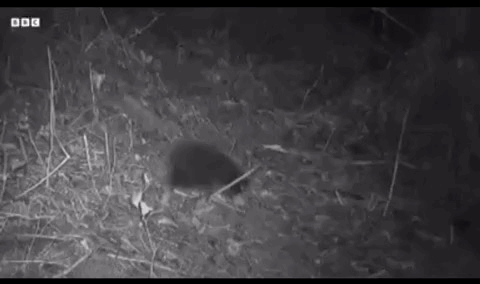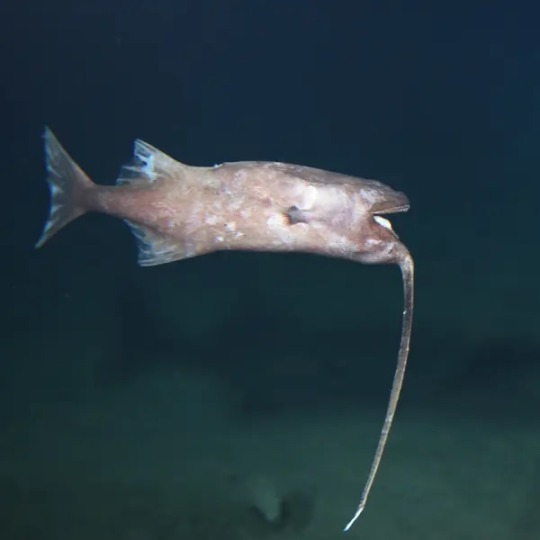#aslzoology
Text
New animals just dropped. E.g.

EDIT: for similar articles you may wish to browse the tag #aslzoology they won't all be of cute animals but it will be mostly environment or nature related news
#LOOK AT HIM#aslzoology#asl zoology#zoology articles#studyblr#marine biology#animals#cute animals#nature#ocean
29K notes
·
View notes
Text

Octopuses are usually solitary, but the gloomy octopus Octopus tetricus live in very high densities. Perhaps due to this living arrangement, scientists have captured footage of octopuses throwing stuff at each other, everything from silt to shells to algae. A few evidence to suggest this throwing is deliberate (not just octopus coincidentally flinging something in the direction of another octopus):
Throwing requires an unusual positioning of the siphon (think jet water propulsion device)
The things that get thrown make pretty strong contact with the receiving octopus
Throwers often exhibit uniform dark/medium colour, suggesting that these throws are linked in some way (not random throw events)
Octopus in the receiving end have been shown to try and dodge the missile
Choice of missile is often silt, and not random
Throwing is often done using a specific set of arms
Scientists think it might be some sort of communication. But it's not clear what sort, e.g. whether antagonistic or not, or is it play, enrichment etc.
#aslzoology#asl zoology#zoology articles#studyblr#octopus#marine biology#cute animals#tentacles#animals#cephalopods#nature#ocean#conservation#animal behaviour#zoology
912 notes
·
View notes
Text
Really cool article. Toxoplasma gondii is a parasite that infects cats (yes the one that poses a risk to pregnant women). When infecting something that's not a cat, the parasite is known to increase the "boldness" of the individual (e.g. it messes up with a rat's brain to make it less afraid of cats > rat more likely to be eaten by cat > parasite is only able to complete its life cycle in cats and thus benefits from the rat bring eaten). In a separate study, infected hyenas are more likely to be eaten by lions.
Here, the study was done on wolves in Yellowstone National Park. Wolves prey on cougars which carry the parasite. Infected wolves are more likely to venture off on their own, start a pack and lead the pack (i.e. be the only breeding pair in the pack). In the past though, infected wolves may have been more likely to be eaten by American lions (now extinct).
#aslzoology#asl zoology#zoology articles#studyblr#nature#wolves#cats#parasites#ecology#sustainability#animals
260 notes
·
View notes
Text
Interesting new discovery!!
Oak wasps lay eggs on oak tree leaves. This stimulates the oak tree to form a gall around the egg. The gall eventually falls off (with the eggs inside) and are harvested by ants. These ants harvest galls because gall caps contain nutritious fatty acids. The ants bring galls back to their nest, take up the gall caps, and leave the remainder of the gall in their nest, thus protecting the egg from predators.
72 notes
·
View notes
Text
Discovered fossils support the "Necks and Sex" theory in giraffes
Fossil discovery suggests that a giraffe's long neck evolved due to sexual selection (longer necks = greater reproductive success) rather than to reach food better.
Traditionally, it's believed that a giraffe's long neck is to help it reach more food. But this theory doesn't hold considering that giraffes don't always forage from the topmost leaves, and longer-necked giraffes don't survive better than shorter-necked counterparts during droughts.
This discovery show ancient giraffe skulls with a helmet-like structure to aid in fighting-which often happens between males for mates. It's neck bone structure also suggests adaptation to fighting, thus lending support for the theory that a giraffe's long neck might also be used for fighting rather than for foraging.
#aslzoology#asl zoology#zoology articles#zoology#evolution#giraffes#studyblr#ecology#nature#animals#stem#stemblr
122 notes
·
View notes
Text
An embalming workshop unearthed at Saqqara, Egypt, an ancient burial ground, has provided insight on the chemicals used in embalming in ancient Egyptian societies. In this workshop, pots containing labelled chemicals were found. GCMS analysis of the contents revealed that while there were many local materials, some originated from as far as Africa, South Asia, and Southeast Asia. For example, one pot contained elemi, a resin that comes from Canarium trees that grow in Asian and African rainforests. Another contained dammar, also a resin, from Shorea trees in tropical south Asia and southeast Asia. How ancient Egyptian civilisations traded for these materials from Asia/Africa is unclear.
#aslzoology#asl zoology#zoology articles#studyblr#archaeology#stem#stemblr#ancient civilisations#anthropology#egypt#science#nature
50 notes
·
View notes
Text
Good news: giant penis
Bad news: penis does not penetrate female during mating
Good news: sex lasts for 12 hours
Bad news: creepy researchers film and watch the whole time
#aslzoology#zoology articles#asl zoology#zoology#studyblr#bats#animal behaviour#naturecore#animals#mammals#halloween#gothic#goth
11 notes
·
View notes
Text
How the moon devastated a mangrove forest 🌔
In 2015, nearly 10% of mangrove in Australia's Gulf of Carpentaria died off
There was an El Nino effect at that time - tides became lower than usual. But this shouldn't cause such a drastic die-off
Researchers realised that the mangrove thinned every 18-19 years - a superregular pattern
It turns out that every 18-19 years, there's a wobble in the moon's orbit. This translates to lower tides
2015 was wobble year AND El Nino year - leading to extremely low tides that killed off a lot of mangroves
https://www.scientificamerican.com/article/how-the-moon-devastated-a-mangrove-forest/
#zoology articles#aslzoology#asl zoology#studyblr#zoology#moon#mangroves#astronomy#nature#scientific american#stemblr#environment#science#ecology
59 notes
·
View notes
Text
"Nature is healing" is a common phrase during lockdowns. But this isn't entirely accurate, and in fact, can be a bit misleading.
Researchers analysed camera trap data on mammals from 102 sites across 21 countries. Two broad patterns emerged:
1. Animal response varied depending on their position in the food chain. Carnivores were more avoidant of humans and so less active when people were around. Herbivores like deer were more active, possibly due to the "shielding" effect from humans that protected them from their natural predators. Omnivores were mildly tolerant of humans, but became more nocturnal.
2. Animal responses changed depending on the extent to which human presence modified their habitat. For example, more humans can mean more resources for some omnivores and scavengers from garbage and food scraps.
A broad study like this helps researchers understand which animals are more sensitive to human presence, and encourages better co-existence with these wildlife: for example, humans can restrict their nocturnal activity to accommodate wildlife that are active at night in human-dominated spaces.
Note however, that there were a lot more samples from USA and Europe, compared to other regions.

Full paper here (open access)
For similar articles, check out my tag #aslzoology or click the link in my bio 📸
#aslzoology#asl zoology#zoology articles#studyblr#naturecore#animalcore#research#camera trap#covid19
4 notes
·
View notes
Text
After the atomic bombs were deployed on Japan, American and Japanese scientists scrambled to study the survivors of the bombs, as part of the newly formed Atomic Bomb Casualty Commission by USA President Harry Truman, later subsumed under the Atomic Energy Commission
These studies were part of efforts to understand nuclear effects in preparation for the anticipated nuclear war with the Soviet Union, and for USA public support that the bomb did not create some sort of genetic monsters
Japanese survivors received no benefits or support from the Commission, as providing these would be an admission of USA's responsibility in causing this crisis
Survivors only managed to get institutional support from the Japanese government about a decade after the bombing
There was also no real informed consent from survivors about this research
The results of the research were kept secret for USA military planning, hence survivors also did not benefit from the research data. They had no systematic treatment as a result
#aslzoology#asl zoology#zoology articles#oppenheimer#nuclear#nuclear bomb#USA#social justice#japan#hiroshima#atomic bomb
16 notes
·
View notes
Text
Very happy that the article also mentioned the locals that helped the research team explore the forest (albeit super briefly)

#aslzoology#asl zoology#zoology articles#studyblr#echidna#rediscovery#animals#cute animals#naturecore#environment
7 notes
·
View notes
Text
Duckweed Power!
There are a number of issues with existing biofuels (usually soybean) - e.g. many crops go to biofuels instead of food, an biofuels are taking up more than 100 million acres of agricultural land.
Duckweed is common in every continent, grows fast and grows in water (including polluted water from animal agriculture - potentially cleaning these waters up a little), which means it doesn't compete with food agriculture for space.
An issue with genetically engineering biofuel plants is that the plants usually produce a lot of fuel at the start, then stop growing completely
A team of scientists, whose research is featured in the article above, have devised a method to allow duckweed to produce 7 times more biofuels. They insert a gene that is inactive into the duckweed, allow the plant to grow fully, before activating that gene for them to produce biofuels.
For more similar articles, see my tag #aslzoology or there's also a link on my blog
#aslzoology#asl zoology#zoology articles#biofuels#studyblr#duckweed#engineering#stem#genetic modification#environment#greta thunberg#climate change#STEM#women in STEM#stemblr
22 notes
·
View notes
Text
Australia's environment is greatly deteriorating - this includes native vegetation, soils, coastal areas etc.
Climate change compounds ongoing and past damages from pollution, land clearing etc to affect every ecosystem in Australia
Indigenous knowledge and management has helped to bring about positive changes, but Indigenous communities need to be further empowered
Environmental management isn't well managed - we are increasing land clearing of native habits etc while relying more on costly ways to save biodiversity, such as habitat restoration, translocation/reintroduction and ex-situ conservation (e.g zoos)
Environmental destruction harms our wellbeing
Climate change is affecting ecosystems severely - including 'unprecedented' and severe floods, droughts, heatwaves, storms and fires. These extreme events are detrimental to ecosystems, such as mass die-offs of spectacled flying foxes and coral bleaching
Indigenous voices must be included and nature and culture cannot be managed as separate entities
Better and novel approaches to environmental management is required, as climate stress, habitat loss and habitat degradation continue to affect Australian biodiversity
Individuals, businesses and private entities are increasingly taking action to protect our ecosystems and such efforts can be leveraged upon. Private-government collaborations can be augmented
#aslzoology#asl zoology#zoology articles#studyblr#australia#australian biodiversity#australian wildlife#wildlife#animals#plants#environment#sustainability#cottagecore#zoology#stemblr
59 notes
·
View notes
Text
Whipnose anglerfish, like other anglers, have a lure in front of them, but theirs is four times their body length. For the first time, these whipnose anglerfish are confirmed to swim and move upside down. This may be to avoid biting their own bodies (the lure) when they attack faster and larger prey.
P.S. this applies for females only. Males are
"sad little tadpole things” a fraction of the size of the females, and without the lure.

#aslzoology#asl zoology#zoology articles#zoology#studyblr#marine biology#anglerfish#naturecore#oceancore#ocean#fish
4 notes
·
View notes
Text
This is to inform everyone that we have a new chonk fish who's an absolute unit at 2744kg (more than 6000 pounds). As a comparison, the winner of this year's fat bear challenge weighed 1400 pounds. The fish in particular is a sunfish (Not Mola mola but the almost identical Mola alexandrini)
29 notes
·
View notes
Text
A very interesting article on the way PhD programmes work! I particularly agree with having more than one supervisor - I've had too many friends taking PhDs with shitty supervisors (the kind that takes in 20 students per year) and having to only rely on those supervisors.
#aslzoology#asl zoology#zoology articles#studyblr#phD#women in stem#stem#science#education#universities#study
17 notes
·
View notes